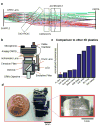An open source, wireless capable miniature microscope system
- PMID: 28514229
- PMCID: PMC5955387
- DOI: 10.1088/1741-2552/aa6806
An open source, wireless capable miniature microscope system
Abstract
Objective: Fluorescence imaging through head-mounted microscopes in freely behaving animals is becoming a standard method to study neural circuit function. Flexible, open-source designs are needed to spur evolution of the method.
Approach: We describe a miniature microscope for single-photon fluorescence imaging in freely behaving animals. The device is made from 3D printed parts and off-the-shelf components. These microscopes weigh less than 1.8 g, can be configured to image a variety of fluorophores, and can be used wirelessly or in conjunction with active commutators. Microscope control software, based in Swift for macOS, provides low-latency image processing capabilities for closed-loop, or BMI, experiments.
Main results: Miniature microscopes were deployed in the songbird premotor region HVC (used as a proper name), in singing zebra finches. Individual neurons yield temporally precise patterns of calcium activity that are consistent over repeated renditions of song. Several cells were tracked over timescales of weeks and months, providing an opportunity to study learning related changes in HVC.
Significance: 3D printed miniature microscopes, composed completely of consumer grade components, are a cost-effective, modular option for head-mounting imaging. These easily constructed and customizable tools provide access to cell-type specific neural ensembles over timescales of weeks.
Figures





References
Publication types
MeSH terms
Grants and funding
LinkOut - more resources
Full Text Sources
Other Literature Sources
